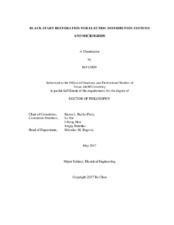| dc.description.abstract | Modern power systems face increased risk of wide area blackouts caused by extreme weather events, man-made errors, cyber-attacks, and other threats. In order to promptly restore power after a blackout, an efficient black start restoration methodology should be developed. Emerging smart grid technologies such as remote control switches (RCSs) and distributed energy resources (DERs) present significant potential that can be leveraged for developing advanced black start restoration methodologies.
In this dissertation research, a new black start restoration (BSR) method, which could be used in distribution management system (DMS) or microgrid control center (MGCC), was presented. The BSR problem was formulated as a dynamic optimization problem in order to coordinate the dispatching actions of DERs and the switching actions of RCSs over multiple decision time steps. Several linearization techniques were presented to reformulate the dynamic optimization model as a mixed-integer linear programming (MILP) model. The rolling-horizon functionality was used to reduce the computation time. The MILP mode was simulated in MATLAB® using YALMIP Toolbox and solved in the IBM CPLEXTM solver.
Several case studies were conducted to illustrate how the new BSR method works on the modified IEEE 13 node and 123 node systems installed with dispatchable distributed generations (DGs), renewable DGs, energy storage systems (ESSs), and RCSs. OpenDSS was used to simulate power flow, and PSCAD™/EMTDC™ was used to simulate frequency response. The new BSR method was able to generate black start sequences in response to varying operating conditions such as balanced and unbalanced conditions, cold load pick up (CLPU) conditions, and different fault scenarios.
The performance of the new BSR method was analyzed through extensive case studies. It was observed that using properly selected rolling-horizon parameters could reduce the computation time and achieve near-optimal solutions. However, some operating conditions resulted in infeasible solutions, such as limited DG ramp rate and capacity, heavy loading conditions, and excessive fluctuation of renewable DG outputs and load demands.
The new BSR method can be further improved by incorporating a method for determining the rolling-horizon parameters without conducting exhaustive case studies and developing an integrated structure to coordinate with DG primary controls. | en |


